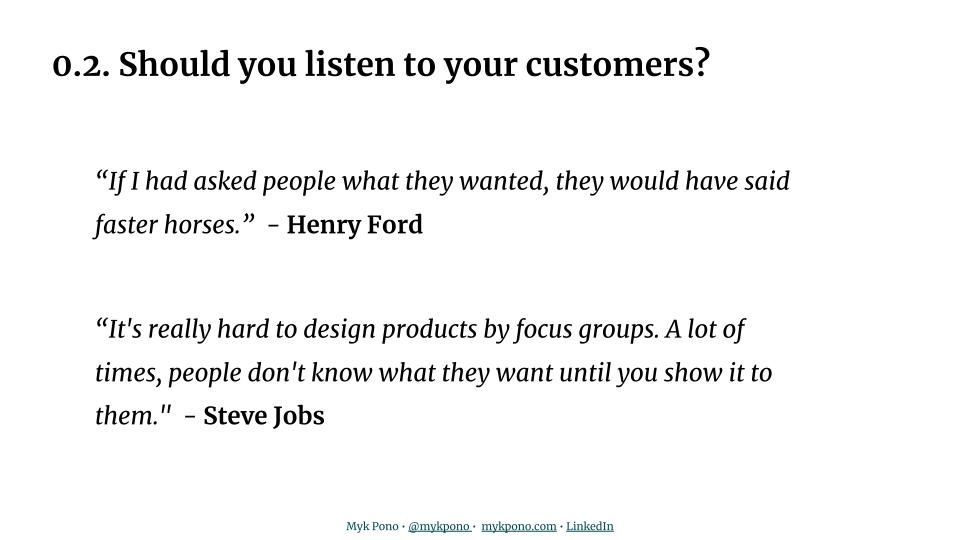Course 0.2: Customer Interviews | Should You Listen To Your Customers?

Updated: https://lab.mykpono.com/free-course-Customer-User-Interviews-13cbee28614780feb9b9fbe594eb145c
0.2. Should You Listen To Your Customers?
In 2015, I worked with a startup called Respondly. They had a product that helps organizations reply and triage conversations on Twitter. It was a cool product!
Slack was one of their first customers. Respondly helped companies like Slack manage all their conversations on Twitter.
For example, if someone asks support a question, you can send this tweet to support and they will respond to the customer directly on Twitter. Or if there was a technical issue, the product manager could respond directly to the customer on Twitter.
The team at Respondly was aware of lean startup methodology and they talked with customers constantly. Since the product could be used by support, sales, and the product teams, they collected tons of product requests from all of these different teams.
And they tried to incorporate all of the feedback from these different target groups.
Seems like a great system, right? But...the product never took off. Why? They let the customers tell them what FEATURES they want.
This is a classic mistake in customer research -- and why there is such a heated debate in the startup world on this topic. Some say you MUST do customer research.
While others say it’s a waste of time. I’m sure you’ve heard this classic quote by Henry Ford, “If I had asked people what they wanted, they would have said faster horses.”
So which is it? That’s what we’re going to get to the bottom of in this video.
Let’s take a look at what some people mean when they say customer research is a waste of time…
Steve Jobs once said, “It's really hard to design products by focus groups. A lot of times, people don't know what they want until you show it to them." There’s even a great book called "Everybody Lies," where the author talks about how big data and people's behavior are more accurate than surveys or interviews.
What this means is that customers are bad at telling you WHAT they need. They’re great at telling you what their PROBLEMS are. That’s what happened with Respondly.
They were too focused on all of the feature requests from users instead of thinking about how they can solve the real problems users were experiencing.
The thing is, people often provide misleading answers. It’s human nature to want to appear better than we are.
So we subconsciously provide misleading answers or answers that make us look better than we are.
As a result, the information customers share during interviews may be misleading or outright false -- leading interviewers to draw the wrong conclusions.
So, why talk to them at all?
Well, let me tell you about a company I worked at called Monster Worldwide. You may know them better as Monster.com.
They were one of the first online job boards and in 2011 it was a 9 billion dollar company and the largest job search destination on the web.
Executives realized a competitive threat that was coming from social media companies like Linkedin and Facebook.
A small competitor, a startup called BranchOut, released a Facebook app that helped Facebook users find and recommend friends for jobs. To compete with them, Monster kicked off a super-secret project - BeKnown, a FB app that will help people find jobs through their social network.
Enormous resources were invested in this project and it was so secret that most of the product team didn't know about it.
It never took off and the project was ultimately eliminated. WHY? People didn’t use Facebook to search for jobs! Back then, users saw it as a private social network to hang out on.
If executives at Monster had taken just a few hours to speak to potential customers about HOW they used Facebook, they would have understood this and saved a ton of money, resources, and time.
It is still surprising that so many people in the organization were convinced they knew what to build and that they never validated their ideas or customer problems with customers.
It was one of the earliest examples in my career on why talking to the customer is a critical step in designing new products.
The point is, you can’t ask your customers to tell you WHAT to build. But you should ask them what PROBLEMS they have, how they behave, how they use your product, and how they think and feel about the problem and your product.
Then it’s up to YOU as the expert to determine what the SOLUTION is and how you can provide VALUE.
If we go back to that classic Henry Ford example, if he asked customers what their frustrations or PROBLEMS are, he might have heard something like “I want to get from here to there faster.”
Then it was up to him as the innovator to determine that what they NEED is the Model T, not a faster horse.
And, frankly, I believe that's exactly what he did. Ford understood the problems people experienced with using horses for transportation.
Now that you understand the difference between asking customers about what product or features they want versus understanding their problems, you are ready to take advantage of customer interviews in the RIGHT way.
